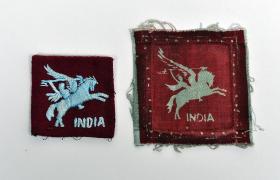
411 (Royal Bombay) Parachute Squadron, RIE
411 (Royal Bombay) Parachute Squadron, RIE
1941 to 1947
411 (Royal Bombay) Parachute Squadron, Royal Indian Engineers (RIE) served as part of 50th Indian Parachute Brigade, then later the enlarged 44th (Indian) Airborne Division. 411 Parachute Squadron was the original Sapper unit of 50
It was initially raised on 20 November 1941 as 411 Parachute Section RIE (equivalent of a Troop) composed of Punjabi Musslemans (PMs) drawn from both the
As part of 50th Brigade troops undertaking jungle training near Imphal in February 1944, 411 Para Sqn were stationed at Litan, 45 miles from Sangshak. After the surprise advance of the 31st Japanese Division in March 1944 there were insufficient transports available for a significant portion of 50th Parachute Brigade and 411 Parachute Squadron was amongst those left at Litan, to which the beleagured Brigade eventually withdrew towards during the Battle of Sangshak.
In May 1945, a Troop of 411 Parachute Squadron formed part of the hastily-formed 'composite' Parachute Battalion sent to Elephant Point to combat a Japanese artillery battery overlooking the sea approaches to Rangoon. Emplaning at Akyab airfield with elements from the two Gurkha Battalions and Field Ambulance, the troops landed successfully and effectively neutralised the Japanese Battery. In the event however, monsoon conditions altered plans by Gen Slim to advance on Rangoon, with the 17th Indian Infantry Division stranded by the inclement conditions at Pegu, 30 miles North of their objective.
Post-independence in 1947, the Squadron was retained as part of 50 (Independent) Para Bde in the Indian Army, and was redesignated as 411 (Independent) Parachute Field Company, Indian Engineers based at Kirkee, near Poona, India. Initially this was in a non-parachuting role however, as the Parachute School had been located at Chaklala (near
Its first parachuting OC was Major S N Sharma, who, many years later became the only Bombay Group Sapper to become the E in C of the Indian Army (as a Lt Gen) – The Indian Army is about 1 million strong and the Sappers, still called by their old titles of Bengal, Madras and Bombay Engineer Groups number, in total, around 100,000. In the fifty years since it was raised, 411 has produced four Lt Generals, five Major Generals and six Brigadiers.
Officers Commanding
Covering the period when the Sqn returned from Karachi to India, Nov 1947
Nov 1947 2nd Lt O Laloo IE
Compiled with kind assistance from Lt Col Pat Munro
Read MoreNewsletter Signup
Donate
Make a donation to Airborne Assault ParaData to help preserve the history of The Parachute Regiment and Airborne Forces
The Airborne Shop
The Airborne Shop is the official shop of Support Our Paras (The Parachute Regiment Charity RCN1131977).
Profits from all sales made through our shop go directly to Support Our Paras, so every purchase you make with us will directly benefit The Parachute Regiment and Airborne Forces.


Latest Comments
There are currently no comments for this content.
Add Comment
In order to add comments you must be registered with ParaData.
If you are currently a ParaData member please login.
If you are not currently a ParaData member but wish to get involved please register.